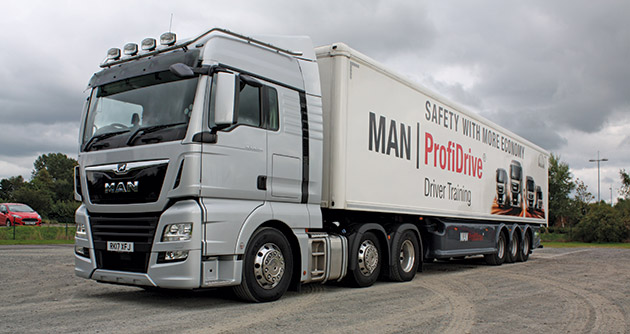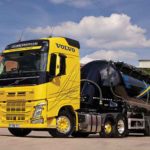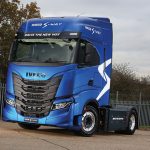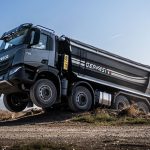
Manufacturers are producing trucks with greater horse power and torque and using innovative technology to bring down the cost of ownership. Kevin Swallow spent the day behind the wheel of an MAN TGX 26.500, a truck that really has the potential to save you money.
WHEN YOU think MAN you think TGX. From a range of vehicles that now goes from 3.5 tonnes gross vehicle weight (GVW) with the TGE, to 44 tonnes in the UK, the TGX is the biggest seller.
Since TGX was launched in 2007 to replace the TGA, it has gone through a continued but gradual transformation. Going from Euro 5 to Euro 6 the revamp on the outside saw the lion logo move upwards to a chrome strip above the reflective grille. The A-posts and the corner deflectors were also redesigned.
A new plastic bumper was introduced with what MAN call a ‘slatted’ structure of three bars that can be found between the set of headlights to improve the air flow into the engine. Operators looking for something fancier can go with chrome slats.
In 2016 MAN overhauled the D26 12.4 litre driveline providing an extra 20hp across the range that raised the power outputs to 420, 460 and 500hp respectively. It also added an extra 200Nm torque to increase each to 2,100, 2,300, and 2,500Nm.
For the Transport News road test, MAN presented its most powerful D26; the 26.500. The badged ‘500’ actually delivers 493hp from 1,800rpm, and 2,500Nm torque from 930rpm through to 1,350rpm.
Fitted with the well established Tipmatic 12 speed (which is the ZF Traxon) with direct top gear, it is also specified with EasyStart, which allows the driver to ease away from a standing start in idle. It has EfficientRoll, or eco-roll, to help save fuel and the global positioning system (GPS) mapping combined with cruise control, better known as EfficientCruise, was launched at the same time as the revamped engines in 2016.
The stretch from the beginning of the Transport News test at Carlisle is a decent run to Glasgow up the M74. This gives us time to see and feel EfficientCruise in action. It uses GPS to detect and anticipate inclines and descents while the truck is in cruise control.
EfficientCruise adjusts the speed of the truck to use as much existing kinetic energy as possible to reduce the amount of fuel used. For the record MAN is claiming EfficientCruise can save up to 9% on fuel costs.
For drivers, cruise control means a consistent speed over hill and down dale without having to do much. More often than not, drivers, good, bad or indifferent, tend to switch off EfficientCruise because they feel it curtails momentum. Often cited, is the truck slowing at the top of a hill when the driver wants to crack on, and on a descent prior to another hill climb it holds you back so the truck doesn’t over speed.
It seems a ‘smart cruise control system’ carries the same stigma as adaptive cruise control (ACC) that uses radar to identify the speed of traffic ahead of the truck and slows the vehicle autonomously to avoid collision. Despite the clear safety and fuel efficiency benefits drivers prefer to get up close and personal before going around a slower truck, rather than get caught behind.
And so it went in the lead up to Beattock. Once you’ve climbed the first gradual incline from J15 northbound there is a dip before it climbs again. In EfficientCruise mode the truck slowed on the descent and activated the engine brake before rolling into the climb up the second part. That stalling gives the impression that valuable time, in an industry regulated by time, is lost.
To champion EfficientCruise MAN’s driver trainers refer to tests they have done that show using a smart cruise control system does not lose the driver valuable time, something Transport News will put to the test in a future issue.
Perhaps EfficientCruise’s best terrain is undulating roads with gradual rises and falls so the engine is constantly adjusting its power output and is able to maintain a consistent speed throughout.
The alternative is the speed limiter option, which can be set at different speeds, and works well in built up areas where lower national speed limits are commonplace.
One device that really worked well, especially on the A-road section is the brake pedal memory. If you are dropping downhill, a tap on the brake pedal sets a speed memory so that if the truck goes over it, the engine brake automatically kicks in to rein back the vehicle.
The 2.53:1 rear axle ratio means at 53mph the rev count is a tad below 1,200rpm. On the climbs there is the best part of 300rpm to play with at the peak torque plateau which goes down to 930rpm. Being able to lug below 1,000rpm saves a gear change or two.
At 50mph the revs sit happily at 1,090rpm which on the A-roads gives you some wiggle room on the inclines to lug down, but a change down the box is usually taken as that’s designed to stop the truck stalling.
The extra 20hp and 200Nm torque helped achieve 3 minutes 27 seconds on the first timed hill at Cairnie Braes, on the A9 northbound between Dunblane and Perth. On the climb the truck dropped to 10th gear and 36mph.
The TGX 26.500 was 12 seconds slower than the Volvo FH540 6×2 tractor unit (TN, January 2018) that boasted 532hp and 2,600Nm torque from its 12.8 litre driveline, but a full 20 seconds faster than the Volvo FM450 6×2 tractor unit with its 10.8 litre engine with 435hp and 2,100Nm torque (TN, October 2017).
For this road test the TGX came with the XLX sleeper cab with a high roof. It’s 2,440mm wide and 2,280mm long, and weighs 40kg more than the smaller XL sleeper cab, and 45kg less than the larger XXL sleeper.
There is a slight engine tunnel step of 120mm, and from the central floor to the ceiling it is 1,820mm (5ft 10in). When you consider that the XL has only 1,540mm (5ft) standing room above the engine tunnel, and the XXL commands 2,030mm (6ft 6in), XLX is literally a halfway house.
Under the bottom bunk is a slide out cool box, and a pull up handle opens up into a table. There’s also a storage facility that can be accessed from the outside.
The bottom bunk is 700mm wide behind the driver’s seat and extends to 790mm, and it is 2,125mm long. If you drop the upper bunk, which in this case is a hammock, there is 690mm of headroom, and above the hammock it’s 500mm to the ceiling.
Cruise control, radio controls, telephone and engine information are all housed on the multi-function steering wheel while two banks of switches by the drivers left knee operate the mid-axle lift, lane departure and temperature controls. On the driver’s door are the electronically controlled windows, mirrors and central locking.
Internally MAN has gone for a combination of sand and graphite colours. Of course, ergonomic beauty is in the eye of the beholder, so it’s worth noting that the alternatives are aluminium, black and wood.
If you get given a cab with the hammock in it, storage is significantly improved. Pull the hammock halfway across the runners and it clicks into some slots creating a long and deep trench to store just about anything.
While the working environment is first-rate, the practicalities of driving require a little bit of faith. Key is convincing the driver that by using the EfficientCruise they’re not going to lose valuable time en route.
When the truck eases back on the power at the crest of a hill in anticipation of the speed returning as the truck drops down the other side, drivers perceive it as ‘not cracking on’ and, more often than not, the boss is slow in recognising that a driver using EfficientCruise properly is actually saving fuel. So the incentive to use it while driving is rarely there.
This is a problem for all the manufacturers who employ a smart cruise control system, yet after a day of letting EfficientCruise dictate proceedings around the Transport News test route I would be hard pushed to argue against it. On a few hill climbs we did lose ground on some other trucks as a result, but we caught them up again so it made little difference.
To sell something like this you need to be able to convince the driver that using EfficientCruise will not hamper their efforts to do their job and show the boss they can save money. The truck does the job properly; convincing the industry is the next challenge.
Operator’s Verdict
Cannock based transport company Go Direct took delivery of two new MAN TGX 26.520 tractor units, rewarding two drivers for their dedication. Gary Oliver, who runs the business with his wife Karen, said: ‘We are always looking to reward our good staff with the best trucks available to us and the two drivers who have received these MANs are absolutely delighted with them.’
The pair of TGX 26.500 6x2s are powered by the 12.4 litre D26 engine and fitted with the XXL cab. Gary said: ‘We are looking for the best deal on the best spec and MAN was able to come up with these units fitted out with alloys and leather seats and the top equipment at the right price. We have had MANs previously, and we are pleased with these new vehicles and the overall service we have received from the sales team.’
Route Logistics, based in Northampton, acquired six new MAN TGX 26.500s after a successful trial with a demo vehicle. Amanda Wells, financial director, said: ‘Due to diversifying into different market sectors, the growth within the general haulage and tramping activities of our business leant towards the option for a greater specification vehicle and the MAN TGX 26.500 XXL seemed the ideal fit.
‘We initially agreed on taking three units, but positive results from the demonstrator soon led to us increasing the order to six.’
Chris Robinson, transport operations director, added: ‘The MPG returns on a vehicle of its size were impressive, one driver managed a return of 11.77mpg during their shift. The drivers were impressed with the comfort of the ride, spacious interior and the general performance.’




